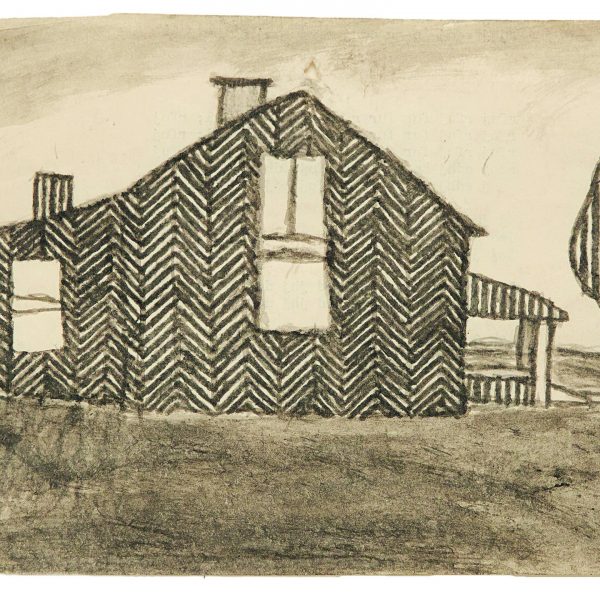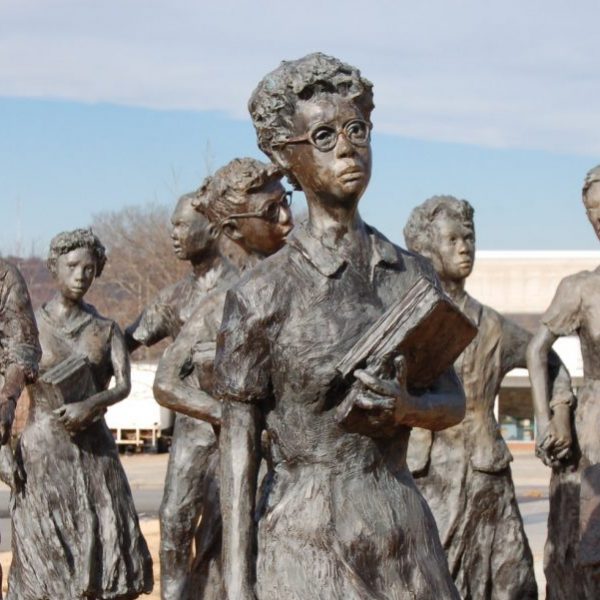David Margolick on Writing the Story of Elizabeth and Hazel

David Margolick, Little Rock Central High School, photo credit Lawrence Schiller
Today, we officially publish David Margolick’s new biography, Elizabeth and Hazel: Two Women of Little Rock, looking at one of the most unforgettable photographs of the civil rights era and recounting the impact on the lives of Elizabeth Eckford and Hazel Bryan Massery. We’ve shown you the book trailer, and now, we ask Margolick what his experiences as a journalist brought to this remarkable story.
Yale University Press: Your previous book, Beyond Glory, was about the great boxing matches between Joe Louis and Max Schmeling. How did you get from there to Little Rock, 1957?
David Margolick: Actually, I began the two projects at roughly the same time. While in Little Rock to do a Clinton-related magazine story in 1999, I visited the museum across from Central High School. Like so many others, I well knew the picture of Elizabeth and Hazel from 1957. So I was flabbergasted to see a poster there showing the two of them, now grown women, standing next to one another, smiling, apparently reconciled. I was amazed and intrigued: how had that happened? It seemed inconceivable. So I began gathering material on it. The two projects share a lot, in addition to their racial themes; each focuses on a discrete event – the first, a fight lasting about two minutes, the second, an exposure lasting probably a sixtieth of a second – to illuminate an entire epoch.
YUP: Was it difficult to find Elizabeth and get her to speak with you?
DM: It wasn’t hard to find Elizabeth; she was in the same house she’d lived in the day the picture was taken. I had expected her to be resistant but she wasn’t at all, particularly once we got going. Elizabeth has an enormous respect for history and the historical process—had her path been truly clear, she would have been an excellent historian—and I think she respected my methodology. That clearly mattered more to her than my point of view; she never even asked about that.
YUP: And Hazel?
 DM: Hazel, to my surprise, was much more reluctant. Though she left school when she was seventeen, she’s read widely in the history of American race relations, and knew of the historic alliance between blacks and Jews. For that reason, among others, she feared that Elizabeth and I would gang up on her. I made a very poor impression on her in our first meeting, and as the fragile friendship she’d struck up with Elizabeth faltered, her position toward me hardened. It was only seven years later, after a very early version of this story appeared in Vanity Fair, that she relented. From that piece, I think, she came to feel I would give her a fair hearing. Then she opened up to me, and I came to realize how remarkable a person she, too, is.
DM: Hazel, to my surprise, was much more reluctant. Though she left school when she was seventeen, she’s read widely in the history of American race relations, and knew of the historic alliance between blacks and Jews. For that reason, among others, she feared that Elizabeth and I would gang up on her. I made a very poor impression on her in our first meeting, and as the fragile friendship she’d struck up with Elizabeth faltered, her position toward me hardened. It was only seven years later, after a very early version of this story appeared in Vanity Fair, that she relented. From that piece, I think, she came to feel I would give her a fair hearing. Then she opened up to me, and I came to realize how remarkable a person she, too, is.
YUP: Did you have any idea that their personal stories would intersect in such a fascinating way?
DM: I knew, from the poster, that they’d come together again. But only later did I learn that five years or so after the picture was taken, Hazel had called Elizabeth to apologize. That was enormously significant to me, a crucial key to her character. It said to me that for all the skepticism and hostility Hazel has encountered over the years, she in fact did the right thing in the right way: early on, when no cameras were rolling, no one was looking. Nor did I initially understand the complex factors that led their relationship to unravel. Thanks to the famous photograph, people held them up as symbols of American race relations in 1957; in some ways they’ve remain that more than fifty years later.
YUP: The book took you twelve years to complete. Why so long?
DM: Well, apart from the multitasking that all journalists must do these days, the story turned out to be endlessly rich. I kept discovering more people who’d been touched by the picture—in Little Rock, in the United States, around the world, at the time it was taken and in the decades since. I interviewed dozens of people, some repeatedly, including seven of the other eight of the Little Rock Nine. I shudder to think how many times I questioned Elizabeth; whenever I told her I was almost certainly done she laughed, because she knew there would be more questions: there always were. Hazel got off more easily, though she, too, put up with a lot of me.
YUP: Can you tell us something about your most recent trip to Little Rock?
DM: It was probably my seventh or eighth; I’d lost count. My reporting was pretty much finished, though of course with any story as good as this, there’s always more to learn. Instead, I accompanied my friend Larry Schiller as he took portraits of the two women. We thought it essential to capture how two faces that are so seared into the national memory had evolved with time and experience. Two of those very penetrating photographs appear on the jacket of my book. Being with Elizabeth and Hazel one last time, and recording them once more for history, was very moving to me—the culmination of one of my most rewarding journalistic experiences.
David Margolick is contributing editor, Vanity Fair, and a frequent contributor to the New York Times Book Review.




I usually read three or four books at a time, but when I got about a third of the way through “Elizabeth and Hazel,” I abandoned the others and finished it. I also cried several times. Let me tell you why:
In the fall of 1956, when I was a senior at Central High, I took a job selling shoes at a store on Main Street. Working in the storage room, and sometimes waiting on a black customer was Ernie Green. He played tenor sax, and I was a jazz fan, so we talked a lot. The next year, when I as a college freshman 30 miles away, and he was going through hell at Central, I mentioned him to some friends who were still in school there. It’s my belief that they befriended him. When I visited a bedridden friend who lived on Park, next to the service station, I was followed by Guardsmen with rifles.
Two years later, I went to work at the Democrat Sunday Magazine with Will Counts. When the schools reopened that fall, I carried film back to the office for him.
Before he left LR for the AP in Chicago, I bought, for $100 the Nikon with which he took, the famous pictures. I subsequently dropped it in a hotel room in Berlin in 1983 and could not get it fixed. I later sent it to Will. When I met Vivian several years later, she said Will’s son was trying to have it fixed. I don’t know if he ever did.
In the late ’60s, after marriage, graduate school, a stint as ME and editor of a weekly in North Little Rock, I was hired by Gene Foreman as city editor of the Democrat. I suspect I assigned Steele Hays to interview EE.
I moved to the Atlanta area in 1982 and joined the Journal-Constitution in 1983. I spent 20 years there as copy chief, city editor and, finally, copy editor after the bastards went home every night.
I’ve read quite a bit about Central, including books by Will and Elizabeth Huckaby, and consider the one your wrote among the best.
Regards,
Ralph Patrick.